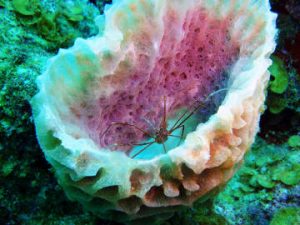Watered Down Medicine: The Influence of Marine Organisms in Medicine
By Gabi Goodrich, RJD Intern
Ancient people worshipped, prayed, and sacrificed to the ocean for the powers of healing and power it possessed. While the mentality has changed, the influence over people and medicine today has not. With more and more focus on disease and sickness, the search for new and better medicines are an exponentially growing field. Over the past 20 years, around 10,000 known natural substances have been found from isolating marine organisms. Only a mere 28 of these are currently in clinical testing, and some are in pretrial. While only a small number of drugs on the market today are actually derived from marine organisms, the appeal of the new source can be found in the differential compounds of marine dwelling organism versus land-dwelling ones. These few organisms that have been approved by the Food and Drug Administration (FDA) do play an everyday role in the medical field and technology. Horseshoe Crabs have been widely used for their blood, which is used to screen intravenous drugs for bacteria contamination. Still, it is important to remember that marine organisms are not just the macrofauna, but also include sponges, cyanobacteria, corals, and algae. For example, the chemicals located in cyanobacteria have been found as an effective malaria treatment. Sponges also appear to be a very promising field. Researchers found that many species of sponges, such as Tethya crypta, show signs of anticancer and antiviral agents. Though, many discoveries have already been made using sponges. The drug Halaven, used for metastatic breast cancer, was originally derived from the Halichondria sponge family. Furthermore, the work with nucleosides in the Caribbean sponge Cryptotethya crypta had set the basis for the synthesis of Ara-C, which created Cytarabine, used to treat cancers of white blood cells, in 1969.
It is essential to state that there is a definite paradigm shift in the view of marine organisms as a viable source for new medicines and advances. Scientists are also turning to corals for their naturally occurring source of prostaglandins, which are hormones manufactured in tissues that control activities such as blood clotting and complex inflammatory responses. The trials using prostaglandins are still ongoing. A less common, yet highly used, breakthrough was the use of conotoxins from the venom of marine cone snails. In the natural environment, snails would use this venom to paralyze their prey. In humans, this venoms attack the metabolism at given points. However, a modified mixture of this toxin provides a morphine-alternate and provides a more powerful painkiller than morphine. This discovery came thirty years after the discovery of Ara-C.
The most recent contribution from marine organisms to medicine is the advancement of trabectidin, an alkaloid, from Ecteinascidia turbinata, the mangrove tunicate. In 2008 the Food and Drug Administration approved Yondelis, which is used in antitumor treatment and prevents resistance to chemotherapy. The possibilities for the use of marine organisms and the compounds derived from them are endless. However, many obstacles must be overcome in order to even start testing using these compounds.
With so many advancements, the problem does not lie in the potential of the ocean but rather the resources of location and production. 95% of the ocean has yet to be explored. With such a vast expanse to explore, the technology does not yet support the collection and storage of organisms and molecules. It is important to also remember that pharmaceutical companies work for profit. The time and money it takes to locate and test the organisms far out ways the profit that would be made from the potential new drug, which is why the ocean was overlooked for such a long time. With that being said, the advancement of new technology, the time and effort it takes to test has been reduced significantly from the methods of testing in the past. This in turn, takes less money than in previous years. The DNA sequencing of numerous marine organisms make it easier for scientists to have a better idea of which favorable DNA sequences are in which organisms in a short amount of time. Yet another hurdle is how to handle the problem of exploitation. Professor Steve Yearley, head of the ESRC genomics forum, explains while there are controls for regulating the exploitation of animals, plants and microbes on land, regulating them at sea is going to be infinitely more difficult “We cannot stop pirates off Somalia, so how is someone supposed to protect rare sponges that they find in their coastal waters?” Moreover, because many of these organisms are in limited quantity, the susceptibility to changes like temperature, salinity, acidity threatens to destroy them. With the rapidly changing world it is important to protect the oceans and what they could hold.
Works Cited
“Medicines from the Sea.” NOAA. National Oceanic and Atmospheric Administration, n.d. Web. 2 Oct. 2014.<http://www.noaa.gov/features/economic_0309/medicines.html>.
Davis, Alison. “Medicines By Design.” Chapter 3: Drugs From Nature, Then and Now. National Institutes of Health, July 2006. Web. 2 Oct. 2014 <http://publications.nigms.nih.gov/medbydesign/chapter3.html>.
Gerwick, Bill. “Introduction to Drug Discovery From Marine Organisms.” (n.d.): n. pag. Oregon State University. Web. <http://agsci.oregonstate.edu/aquatic-bt/sites/default/files/Gerwick-New_Medicines_from_the_Sea.pdf>.
Fenical, William. “MARINE BIODIVERSITY AND THE MEDICINE CABINET THE STATUS OF NEW DRUGS FROM MARINE ORGANISMS.” 9.1 (1996): n. pag. The Oceanography Society. Web. <http://www.tos.org/oceanography/archive/9-1_fenical.pdf>.
Levins, Nicole. “Coral Reefs and Medicine | The Nature Conservancy.” Coral Reefs and Medicine | The Nature Conservancy. The Nature Conservency, n.d. Web. 2 Oct. 2014. <http://www.nature.org/ourinitiatives/habitats/oceanscoasts/explore/coral-reefs-and-medicine.xml>.
Maxwell, Sara. “Medicines from the Deep: The Important of Protecting the High Seas from Bottom Trawling.” (2005): n. pag. Natural Resource Defense Council, Mar. 2005. Web. <https://www.nrdc.org/water/oceans/medicines/medicines.pdf>.






Leave a Reply
Want to join the discussion?Feel free to contribute!